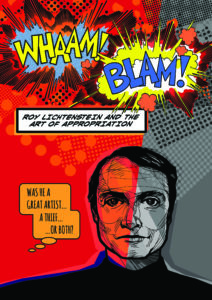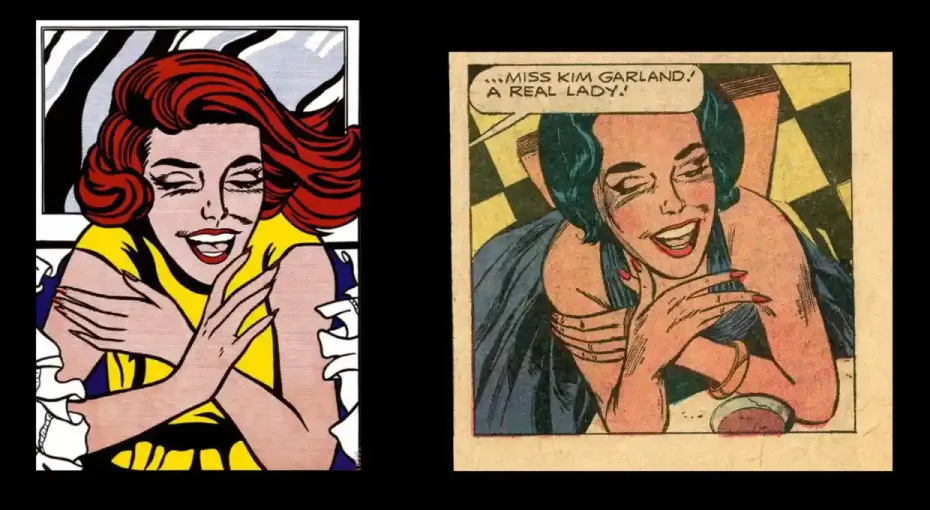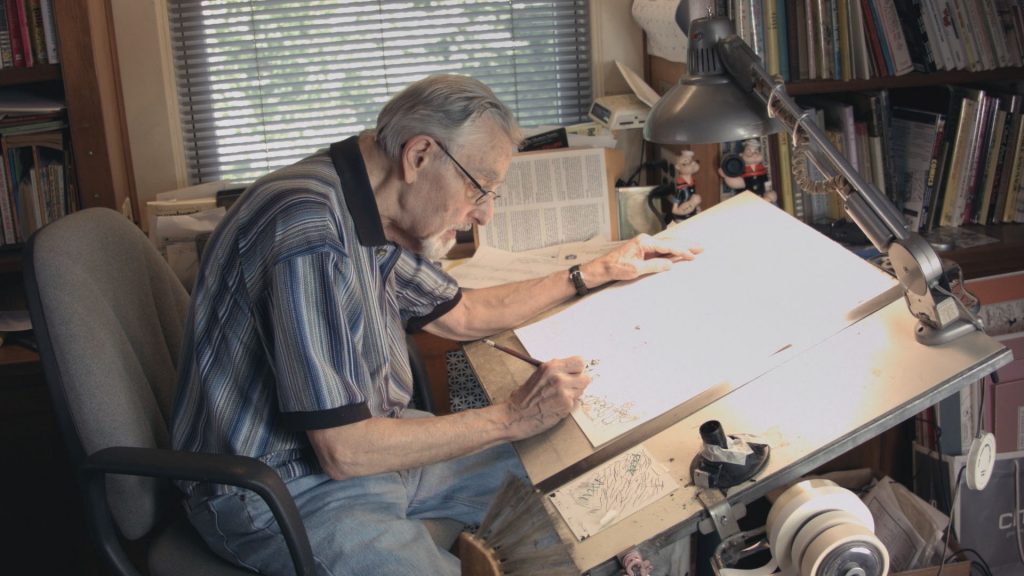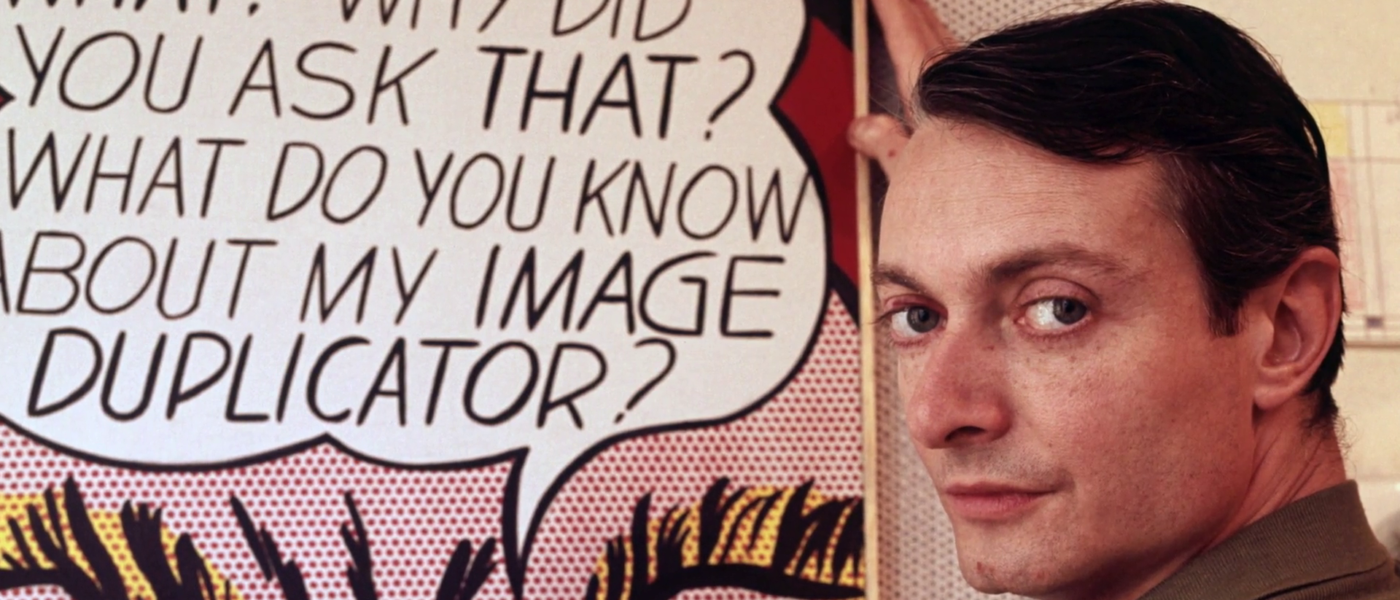New Documentary Connects the dots between “high art” and “low art”
DIRECTED BY JAMES L. HUSSEY/2022
DVD STREET DATE: APRIL 25, 2023/VIRGIL FILMS (via Kino Lorber)

The 1960s: Roy Lichtenstein began incorporating comic panels into his paintings. He framed the gesture as a form of ironic appropriation. His use of comics was meant to recontextualize a form of mass media, if not to examine the bounds of “high” and “low” aesthetics. “The closer my work is to the original,” he explained, “the more threatening and critical the content.”
The comic artists whose works have served as fodder for Lichtenstein’s canvases, however, have a different word for all of it: theft!
*****
Unquestionably, there’s a discussion to be had about theft. “Theft” versus “appropriation”, and the notions therein. Throughout the short seventy-plus-minute duration of James L. Hussey’s WHAAM! BLAM! Roy Lichtenstein and the Art of Appropriation, that discussion is had from every side and then some. It’s a thorough investigation presented on a prosumer level of craftsmanship by someone who knows his subject and enjoys pursuing opinion. Along the way, he speaks to art historians and museum curators who are all too happy to give Lichtenstein the benefit of the doubt. Vitally, he also speaks to comic book artists, including a couple who’d been “appropriated” thusly, all of whom have strong feelings about it.
Two “appropriated” comic artists, Hy Eisman and Russ Heath, are featured at length. Quickly it’s apparent that these are lifelong working illustrators (with careers going back to the Golden Age of Comic Books [1938-1956]) who, at the time of their interviews, are not exactly financially secure. (Heath, one of the medium’s greats, was reduced to living alone on a fixed income and relying on the charity of the non-profit organizations Hero Initiative and the Comic Art Professional Society of Los Angeles. He has since passed away; Eisman finally, finally retired in 2022). Thanks to the archeological efforts of researcher David Barsalou, MFA, seen at his blog “Deconstructing Roy Lichtenstein”, the film features truly head-turning direct comparisons. Barsalou himself is featured throughout the film, discussing his research.

During this most famous and infamous phase of Lichtenstein’s career, he would isolate individual comic book panels that he found compelling, re-rendering them as painted canvases, often employing the Ben-Day dotting technique to further “comic book-ify” them. He’d alter details- tweaking the dialogue, flipping the image, changing the colors- but when compared directly, the source images remain absolutely apparent. Hussey’s film makes the point that Lichtenstein followed Andy Warhol into the newly minted area of fine art as pop culture deconstruction.
The controversy really ramps up when it comes to Lichtenstein giving credit to the original artists. Namely, he didn’t. And when Lichtenstein’s comic paintings soared in value, they saw zero benefit or even recognition. To this day, art-world coverage of Lichtenstein has a pervasive tendency to omit such details. It’s here where the perceived “high art/low art” divide becomes egregiously pronounced.
It becomes simply gross when factoring how various individual Lichtenstein paintings have sold at auction for upwards of $40 million. In 2017, his painting “Masterpiece”, a reworking of a Ted Galindo romance comic book panel, sold for $165 million to hedge fund billionaire Steve Cohen. In the end, WHAAM! BLAM! stands most successfully as a tremendous comparison between the gulf of “realities” of the insular and posh fine art world (“high art”) and the workaday anonymity treadmill that’s driven the populist comic book industry.

There’s nothing fancy about WHAAM! BLAM! that one may expect these days in a documentary on a subject such as this. No animation of the artwork, no flashy transitions, and no celebrities. Only for one quick moment is there a well-known song heard, utilized for the purpose of discussing the differences in the issue of appropriation/theft in the music world. Perhaps that’s to Hussey’s credit. Kino Lorber has brought the Virgil Films release to DVD free of any substantial supplemental features. The presentation itself, however, is quite nice for standard definition.
While I came away appreciative of Hussey’s open-ended exploration of appropriation versus theft in terms of Lichtenstein’s comic work, I wasn’t sure how I felt about it. Everyone who is interviewed on the matter tends to make good points defending their own point of view. So, for this review of WHAAM! BLAM!, I decided to try it out, and appropriate someone else’s review, without initial credit given, but tweaked. The first paragraph and a half of it this review- everything above the “*****” break- is taken from the March 13, 2023 review of the documentary on artnet.com as written by Art & Pop Culture Editor Min Chen. Go read it if you’re so inclined.
Unlike Lichtenstein, I always intended to give proper credit where credit is due. Even then, the whole exercise gave me discomfort. Your milage may vary, but this little experiment leads me to side with the geriatric illustrators. This despite the fact that Min Chen wraps it up at artnet saying, “The film recognizes appropriation as an essential gesture in art, giving due credit to Lichtenstein’s conceptual intent and his Pop legacy.” Yes, yes. That too, I suppose, is true.


